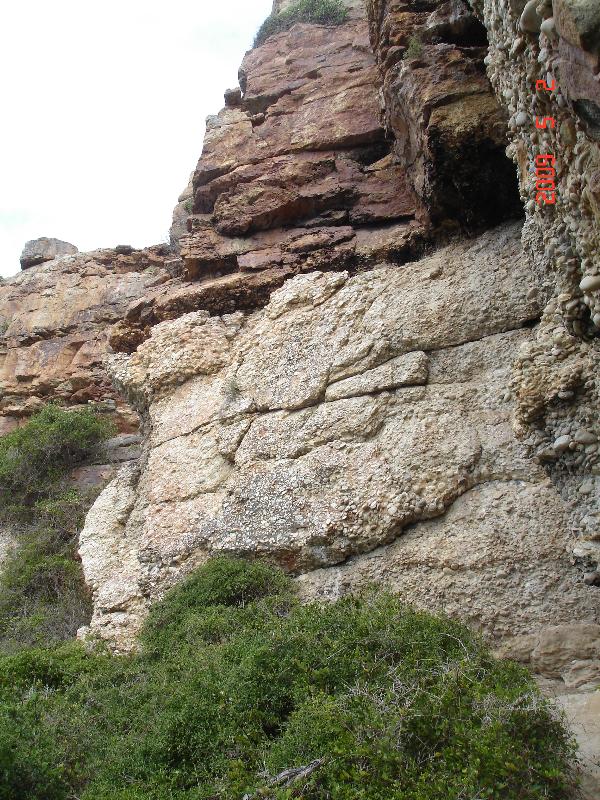ROBBERG

Robberg Formation (150 million years old)
Robberg Formation is the formal name for a geological unit best exposed at Robberg, but it also occurs elsewhere, e.g. Mosselbay and Cape Infante.
The sand and water-worn cobbles hardened while the deposit was buried to more than 1km. High pressure and temperature cemented the grains and cobbles together to form the sandstone and conglomerate.
It was subsequently uplifted by faulting. Volcanic activity played no part anywhere on Robberg.
The Robberg Peninsula is a national monument, nature reserve and marine protected area that lies about 892 south of Plettenberg Bay - a prestigious coastal resort on South Africa's famous Garden Route. The ecology of the Robberg Peninsula is similar to that of other rocky headlands on this coastline and it presents a fine example of how plants and animals adapt to the interacting influences of land and sea.
First evidence of the 'modern' South African coastline. Robberg's rocks date back to the early Cretaceous period (130 - 110 million years ago) and the earliest break-up of Gondwanaland - a prehistoric super continent that split up into latter-day South America, Africa, Antarctica, India and Australia about 120 million years ago. The rocks at Robberg were deposited in the bed of this new African sea.
For more info: http://www.capenature.co.za/reserves/robberg-nature-reserve/
What is Conglomerate?
A conglomerate is a rock consisting of individual clasts within a finer-grained matrix that have become cemented together. Conglomerates are sedimentary rocks consisting of rounded fragments and are thus differentiated from breccias, which consist of angular clasts.
Conglomerates are deposited in a variety of sedimentary environments.
Deepwater marine
In turbidites, the basal part of a bed is typically coarse-grained and sometimes conglomeratic. In this setting, conglomerates are normally very well sorted, well-rounded and often with a strong A-axis type imbrication of the clasts.
Shallow marine
Conglomerates are normally present at the base of sequences laid down during marine trangressions above an unconformity, and are known as basal conglomerates. They represent the position of the shoreline at a particular time and will be diachronous.
Fluvial
Conglomerates deposited in fluvial environments are typically well-rounded and well-sorted. Clasts of this size are carried as bedload and only at times of high flow-rate. The maximum clast size decreases as the clasts are transported further due to attrition, so conglomerates are more characteristic of immature river systems. In the sediments deposited by mature rivers, conglomerates are generally confined to the basal part of a channel fill where they are known as pebble lags. Conglomerates deposited in a fluvial environment often have an AB-plane type imbrication.
Alluvial
Alluvial deposits are formed in areas of high relief and are typically coarse-grained. At mountain fronts individual alluvial fans merge together to form braidplains and these two environments are associated with the thickest deposits of conglomerates. The bulk of conglomerates deposited in this setting are clast-supported with a strong AB-plane imbrication. Some matrix-supported conglomerates are present, a result of debris-flow deposition on some alluvial fans.
Glacial
Glaciers carry a lot of coarse-grained material and many glacial deposits are conglomeratic. Tillites, the sediments deposited directly by a glacier, are typically poorly-sorted, matrix-supported conglomerates. The matrix is generally fine-grained, consisting of finely milled rock fragments. Waterlain deposits associated with glaciers are often conglomeratic, forming structures such as eskers.
Examples:
A spectacular example of conglomerate can be seen at Montserrat, near Barcelona. Here erosion has created vertical channels giving the characteristic jagged shapes for which the mountain is named (Montserrat literally means "jagged mountain"). The rock is strong enough to be used as a building material - see Montserrat abbey front at full resolution for detail of the rock structure.
Another spectacular example of conglomerate, the Crestone Conglomerate may be viewed in and near the town of Crestone, at the foot of the Sangre de Cristo Range in Colorado's San Luis Valley. The Crestone Conglomerate is a metamorphic rock stratum and consists of tiny to quite large rocks that appear to have been tumbled in an ancient river. Some of the rocks have hues of red and green.
Conglomerate may also be seen in the domed hills of Kata Tjuta, in Australia's Northern Territory.
Pottsville conglomerateIn the nineteenth century a thick layer of Pottsville conglomerate was recognized to underlie anthracite coal measures in Pennsylvania.
For more info: http://en.wikipedia.org/wiki/Conglomerate_(geology)

To log your visit, answer the following:
1. How did the pebbles end up in the sand?
2. What action cemented the pebbles and sand together?
3. Is the sollid rock under or ontop of the conglomerate? (Name the Rocks, Top, or Botom)
4. Send answers to me
5. Upload a photo (you and your GPS @ a conglomerate)